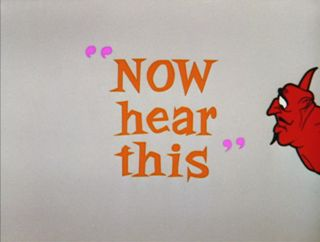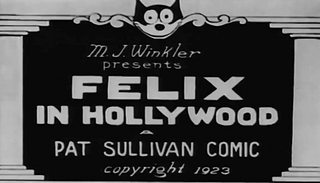Related Research Articles

Animation is a filmmaking technique by which still images are manipulated to create moving images. In traditional animation, images are drawn or painted by hand on transparent celluloid sheets (cels) to be photographed and exhibited on film. Animation has been recognized as an artistic medium, specifically within the entertainment industry. Many animations are computer animations made with computer-generated imagery (CGI). Stop motion animation, in particular claymation, has continued to exist alongside these other forms.

Charles Martin Jones was an American animator, painter, voice actor and filmmaker, best known for his work with Warner Bros. Cartoons on the Looney Tunes and Merrie Melodies series of shorts. He wrote, produced, and/or directed many classic animated cartoon shorts starring Bugs Bunny, Daffy Duck, Wile E. Coyote and the Road Runner, Pepé Le Pew, Marvin the Martian, and Porky Pig, among others.
A brickfilm is a film or Internet video made by either shooting stop motion animation using construction set bricks like Lego bricks or using computer-generated imagery or traditional animation to imitate the look. They can sometimes also be live action films featuring plastic construction toys. Since the 2000s The Lego Group has released various films and TV series and brickfilms have also become popular on (social-) media websites. The term “brick film” was coined by Jason Rowoldt, founder of the website brickfilms.com.

Leon Schlesinger was an American film producer who founded Leon Schlesinger Productions, which later became the Warner Bros. Cartoons studio, during the Golden Age of American animation. He was a distant relative of the Warner Brothers. As head of his own studio, Schlesinger served as the producer of Warner's Looney Tunes and Merrie Melodies cartoons from 1930, when Schlesinger assumed production from his subcontractors, Harman and Ising, to 1944, when Warner acquired the studio.

Pinscreen animation makes use of a screen filled with movable pins, which can be moved in or out by pressing an object onto the screen. The screen is lit from the side so that the pins cast shadows. The technique has been used to create animated films with a range of textural effects difficult to achieve with any other animation technique, including traditional cel animation.

A flip book, flipbook, flicker book, or kineograph is a booklet with a series of images that very gradually change from one page to the next, so that when the pages are viewed in quick succession, the images appear to animate by simulating motion or some other change. Often, flip books are illustrated books for children, but may also be geared toward adults and employ a series of photographs rather than drawings. Flip books are not always separate books, but may appear as an added feature in ordinary books or magazines, frequently using the page corners. Software packages and websites are also available that convert digital video files into custom-made flip books.

Rough Draft Studios, Inc. is an American animation production studio based in Glendale, California, with a second studio in Glendale and its sister studio Rough Draft Korea located in Seoul, South Korea. The studio was founded in Van Nuys, Los Angeles by Gregg Vanzo in 1991.

Claire Parker was an American engineer and animator. A graduate of MIT, her best-known contribution to the history of cinema is the Pinscreen, a vertically-mounted grid of between 240,000 and 1 million sliding metal rods that are first manually pushed into position to create lit and shaded areas, then filmed frame by frame. While the hand-operated, mechanical Pinscreen superficially shares characteristics with early optical toys like the zoetrope, it is distinguished by being one of the first devices ever to produce animation by reconfiguring a set of individual picture elements, later called pixels. A model with sufficient pin "resolution" can be used to create a Pinscreen animation of photorealistic images, a painstaking process analogous to modern pixel art.
Strata-cut animation, also spelled stratcut or straticut, is a form of clay animation, itself one of many forms of stop motion animation.

Now Hear This is a 1963 Warner Bros. Looney Tunes cartoon directed by Chuck Jones and Maurice Noble, and written by Jones and John Dunn. The short was released on April 27, 1963. It was nominated for the Academy Award for Best Animated Short Film the following year.

Linda Simensky is the creative executive for various works of animation. Simensky served as an executive for Nickelodeon and Cartoon Network. She is partly responsible for the development of shows such as Dexter's Laboratory, The Powerpuff Girls, Courage the Cowardly Dog, Samurai Jack and Ed, Edd n Eddy.

Felix in Hollywood is an American silent short film featuring Felix the Cat, released on July 15, 1923. The short was named number 50 of The 50 Greatest Cartoons of all time in a 1994 survey of animators and cartoon historians.
Richard Roger Reeves is a Canadian animated filmmaker. He is known for his whimsical abstract animated films created using a drawn on film technique.
Grown Up is a 1993 7 minute 16mm short animated film by Joanna Priestley, using drawings on paper, pixellated hands and object animation. The film was written by Barbara Carnegie and Joanna Priestley, and directed, produced, and animated by Priestley.

Tom Sito is an American animator, animation historian and teacher. He is currently a Professor at USC's School of Cinematic Arts in the Animation Division. In 1998, Sito was included by Animation Magazine in their list of the One Hundred Most Important People in Animation.
Non-narrative film is an aesthetic of cinematic film that does not narrate, or relate "an event, whether real or imaginary". It is usually a form of art film or experimental film, not made for mass entertainment.
Simon Pummell is a British filmmaker currently based in Amsterdam in The Netherlands, best known for directing Bodysong (2003) a documentary feature film that portrays the human life-cycle through archive footage from across a century of moving image creation.
The Dancing Bulrushes is a 1985 5-minute 16mm short animated film by Joanna Priestley, and Steven Subotnick using sand on top glass, directly under the camera.

The Magic Portal is a 1989 live-action/stop motion animated sci-fi adventure short film written, produced and directed by Lindsay Fleay. Filmed with the Lego line of construction toys, the film is considered to be a significant example of early brickfilms. The film tells the story of an astronaut that finds a mysterious portal that transports him and his crew to strange and wondrous worlds. Fleay appears in a live-action role.
Cameras Take Five is a Canadian animated short film, directed by Steven Woloshen and released in 2003. The film is a scratch film comprising abstract improvisational line drawings set to the tune of the jazz standard "Take Five".
References
- 1 2 3 "ABOUT THE EDITOR." Animation Journal. Retrieved on February 18, 2009.
- ↑ "Back in the 'Family' way [ permanent dead link ]," The Daily Iowan
- ↑ "A Home for Heroes Archived 2013-05-12 at the Wayback Machine ." University of Technology Sydney
- ↑ "Contact." Society for Animation Studies.
- 1 2 "Maureen Furniss Archived 2007-07-31 at archive.today ," California Institute of the Arts
- 1 2 "Le Joueur d'Échecs/The Chess Player (1927).Directed by Raymond Bernard." Johns Hopkins University .
- 1 2 "Electronic Newsletter Volume II Issue 4 Summer 2004 Edition," San Diego State University
- 1 2 "Maureen Furniss Adjunct Faculty Archived 2008-03-16 at the Wayback Machine . University of Southern California .
- 1 2 "Chapman University Graduate Catalog." Chapman University
- 1 2 "Chuck Jones," Encarta . Archived 2009-11-01.
- ↑ "Animation journal," Intute
- ↑ "Chuck Jones: Conversations," University Press of Mississippi
- ↑ ""What's New" Archives: March 2005 Archived 2008-01-27 at the Wayback Machine ," Michael Barrier website
- ↑ "Art in Motion Animation Aesthetics," Indiana University Press
- ↑ "Art in Motion: Animation Aesthetics." Amazon.com
- ↑ "Art in Motion: Animation Aesthetics," John Libbey Publishing
- ↑ "The Animation Bible: A Practical Guide to the Art of Animating from Flipbooks to Flash." Amazon.com
- ↑ "Things of the Spirit: A Study of Abstract Animation." Google Books